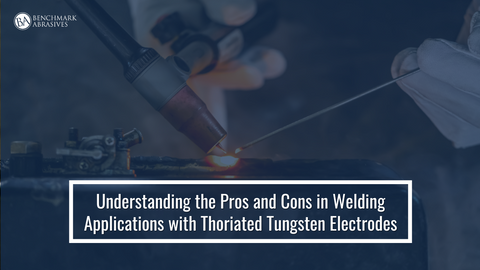
Understanding The Pros and Cons of Welding Applications With Thoriated Tungsten Electrodes

When tungsten is alloyed with thorium, its characteristics change. For example, an electrode of thoriated tungsten may carry more current than pure tungsten. As a result, it can take more heat, and the possibility of tungsten inclusions is decreased. Additionally, it improves the stability of the geometry of the weld arc and facilitates its initiation. Because it adds predictability to the TIG welding process and the welds, thoriated tungsten has been and continues to be a mainstay in tungsten inert gas (TIG) arc welding. But its main flaw is that it is slightly radioactive.
THORIATED TUNGSTEN ELECTRODE
Thoriated tungsten, or 2% thoriated electrodes (AWS order EWTh-2), comprises roughly 2 percent thorium and 97.30 percent tungsten. Because of their longevity and usefulness, they are currently the most often used anodes. Thorium increases the cathode's electron discharge characteristics, which expands the curve and considers a greater current-conveying limit. This anode operates well below its melting point, resulting in a much slower consumption rate and eliminating curve meandering for even greater security. Thoriated terminals reduce weld pollution by having distinct and contrasting anodes and storing less tungsten in the weld puddle.
These terminals are mainly used for anode negative or straight extremity DC welding on carbon steel, toughened steel, nickel, and titanium, as well as AC welding (such as thin-gauge aluminum and materials under 0.060 inches).
When assembling, thorium is uniformly dispersed throughout the cathode, helping the tungsten maintain its sharp edge—the perfect terminal form for thin welding steel—after crushing. Because thorium is radioactive, you should always abide by the instructions, the Material Safety Data Sheet (MSDS), and the maker's warnings when using it.
WHAT IS THE USE OF THORIATED TUNGSTEN?
One common substitution for thoriated tungsten in TIG welding procedures is tungsten alloyed with a different metal oxide, including cerium, lanthanum, or zirconium. Given the abundance of non-radioactive tungsten electrode options, it is reasonable to question why thoriated tungsten electrodes are still in use. The fact that tungsten has a lengthy history of working successfully in almost all TIG welding applications partly contributes to the explanation. It is challenging to replace.
Thoriated tungsten electrodes were used in engineering, practice, and qualification for high-specification welding in the aerospace and nuclear industries. Creating new welding technique requirements is difficult. Thoriated tungsten is also well-liked by welders and is said to be better than other tungsten electrodes at keeping a sharp tungsten grind angle throughout prolonged welding without spitting or splitting.
The only acceptable electrodes for some high-specification welding are still tungsten-thirstated electrodes. Welders frequently like thoriated tungsten, selecting it above other GTAW tungsten electrode types, even in welding operations when alternative electrode types are qualified and available. Thankfully, there are safe methods for handling thoriated tungsten.
The clear benefit of using a pre-ground tungsten electrode that has been thoriated is that there is no chance of coming into contact with radioactive dust. Spent thoriated tungsten electrodes can be easily disposed of by returning them to the manufacturer.
Pre-ground tungsten has a less evident benefit in that the manufacturer can grind the tungsten more precisely and polishedly than can be achieved in a shop or manufacturing setting. This considerably lowers the possibility of tungsten inclusions accumulating in the weld by reducing the number of burrs on the tungsten tip that arises during the machining process. This excellent machining is a big help in high-specification welding operations where thoriated tungsten is still employed.



































































